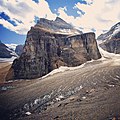| Mount Lefroy | |
|---|---|
 Mount Lefroy | |
| Highest point | |
| Elevation | 3,423 m (11,230 ft) [1] [2] |
| Prominence | 417 m (1,368 ft) [3] |
| Listing | |
| Coordinates | 51°21′44″N116°16′47″W / 51.36222°N 116.27972°W [4] |
| Geography | |
 | |
| Interactive map of Mount Lefroy | |
| Country | Canada |
| Provinces | Alberta and British Columbia |
| Protected areas | |
| Parent range | Bow Range ← Park Ranges |
| Topo map | NTS 82N8 Lake Louise [4] |
| Climbing | |
| First ascent | 1897 [3] |
| Easiest route | West face (UIAA II) [1] |
Mount Lefroy is a mountain on the Continental Divide, at the border of Alberta and British Columbia in western Canada. The mountain is located on the eastern side of Abbot Pass which separates Lake Louise in Banff National Park from Lake O'Hara in Yoho National Park. Mount Victoria lies immediately on the western side of the pass.
Contents
The mountain was named by George M. Dawson in 1894 for Sir John Henry Lefroy (1817–1890), an astronomer who had travelled over 8,800 kilometres (5,470 mi) in Canada's north between 1842 and 1844 making meteorological and magnetic observations. [1]
The mountain is the site of the first fatal accident in modern mountaineering in Canada. In 1896 during a failed summit bid, Philip Stanley Abbot slipped on rocks after just coming off an icy section and plummeted down the rock face to his death. [1]
The first successful ascent was made in 1897 by J. Norman Collie, Arthur Michael, H. Dixon; Charles Fay, Peter Sarbach, R. Vanderlip, C. Noyes, Charles Thompson, and H. Parker. [3]
A prominent painting by Canadian Group of 7 artist Lawren Harris, was painted at this site. [5]










